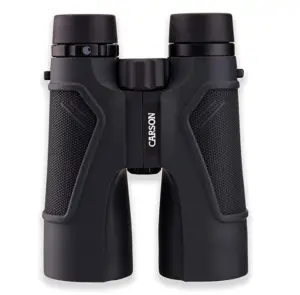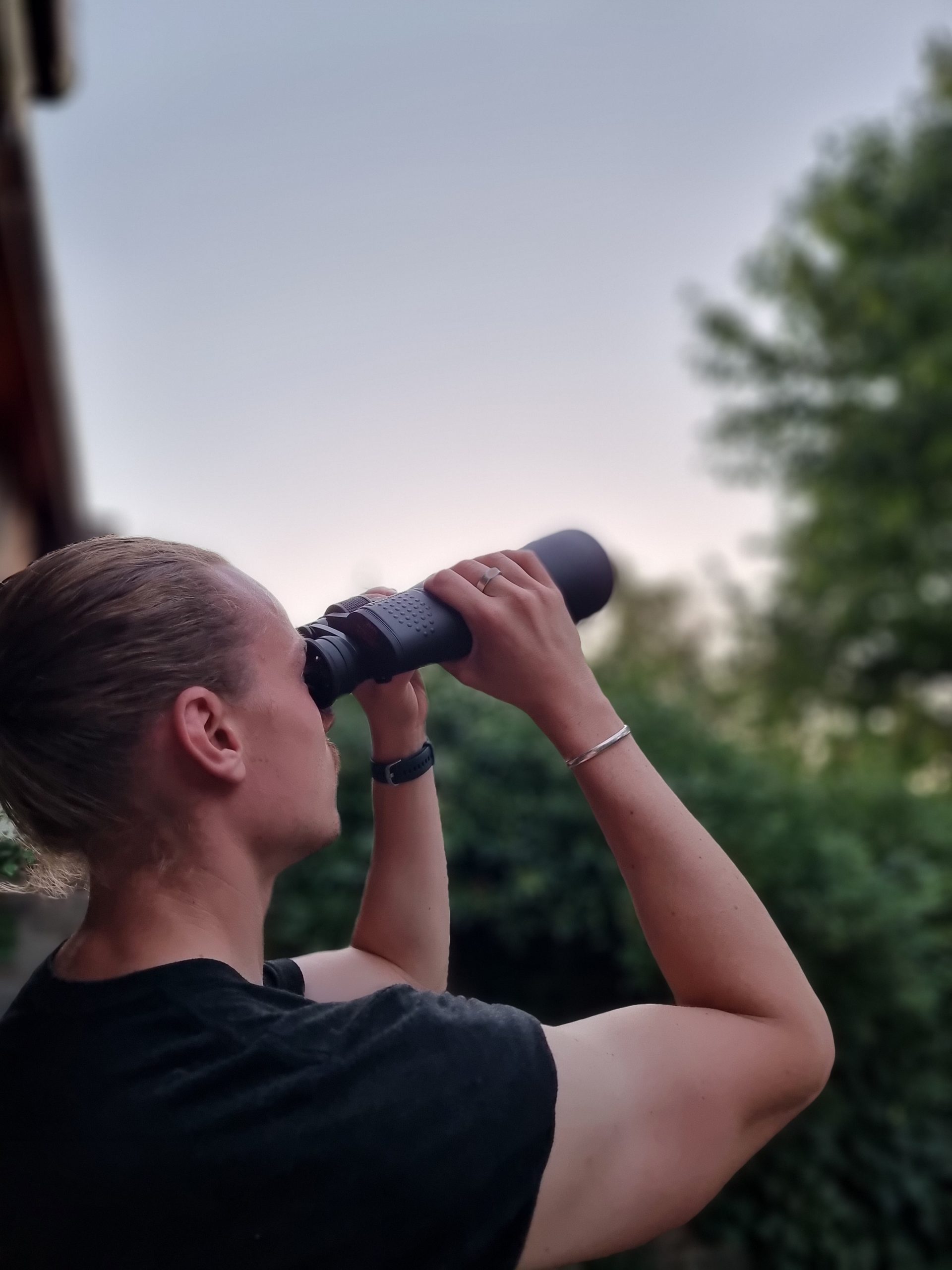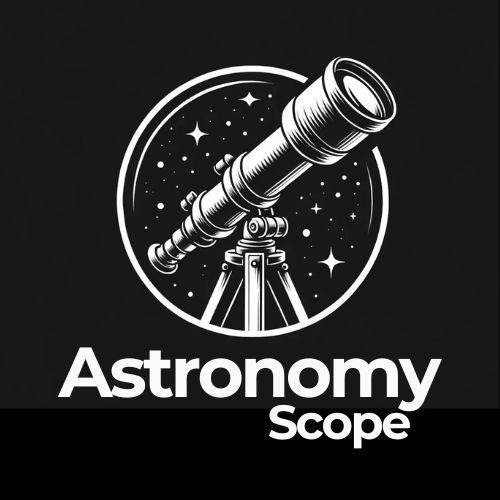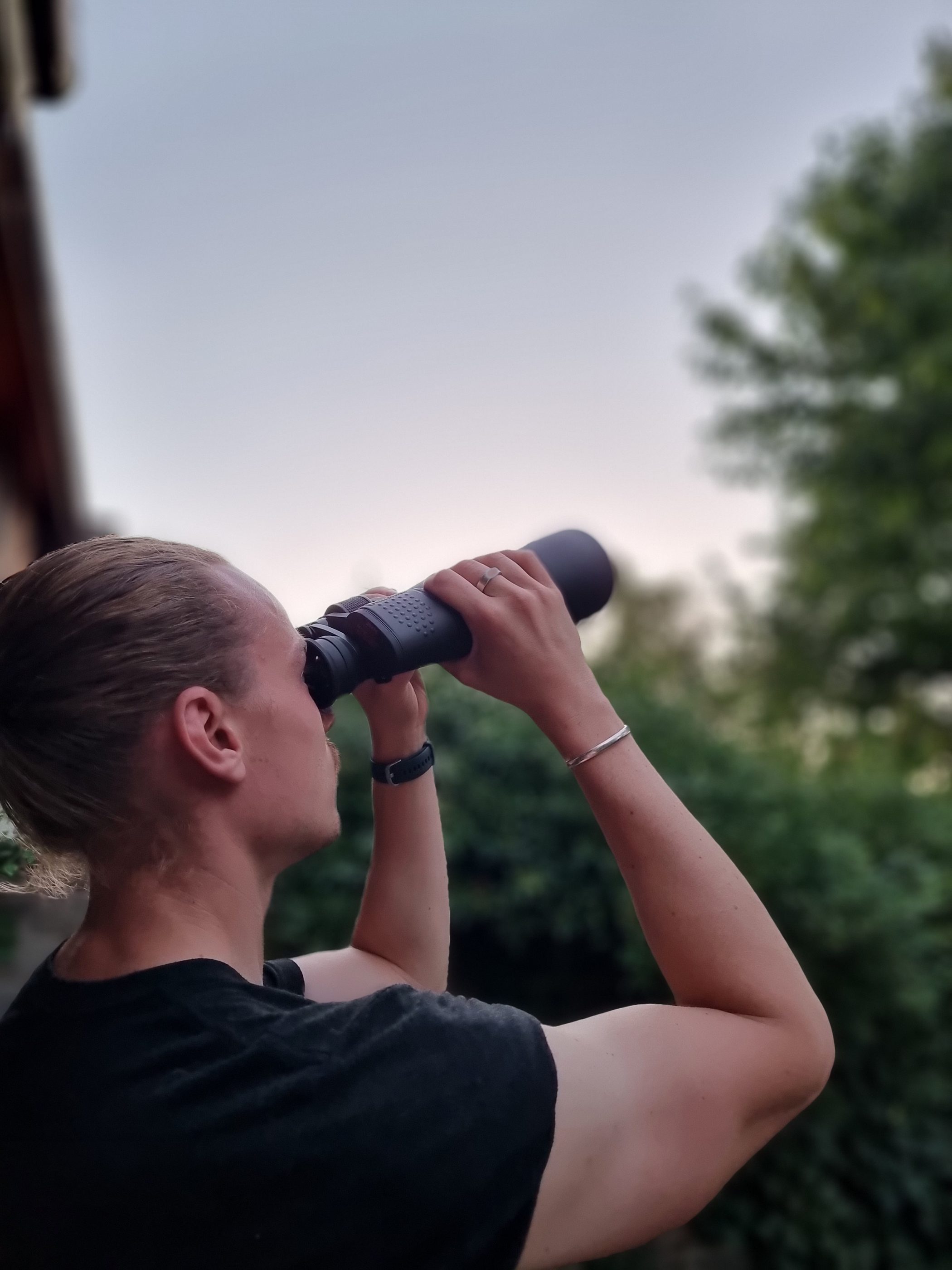Are you looking for the best binoculars you can comfortably hold and observe the night sky? Then you’ve come to the right place.
In my own personal quest to get a new pair of lightweight yet powerful binoculars, I conducted some extensive research.
In the table below, you will see those that made the final cut!
Best Handheld Binoculars For Astronomy






If you are looking to observe the night sky, a pair of handheld binoculars is an excellent and practical alternative to a telescope.
With a wide field of view, ease of use, and no complicated setup; they are ideal for beginners as well as more experienced astronomers alike.
The likelihood is: that if you decide to invest in a good pair of binoculars for astronomy, you will continue to use them- even if you decide to later purchase a telescope.
They are such a versatile and portable tool that they will always be more ideal for use on the go or on your travels.
Having said that, not all binoculars are as lightweight and portable as you may think.
In fact, the more powerful the binocular, the larger and heavier the frames and lenses tend to be.
Does this mean that it is not possible to get a high-quality pair of handheld binoculars to observe the moon? planets, stars, comets, and other Deep Sky Objects?
Absolutely not.
In fact, you can get some of the best views of the night sky with handheld binoculars.
You just need to know what to look for.
Handheld Binocular Details
Celestron SkyMaster Binoculars 15×70 (Editors Choice)
Magnification: 15x
Optical diameter: 70mm
Eye relief: 17mm
Coatings: Multi-coated
Prism: BAK-4 Porro
Water Resistant: Yes
Tripod adaptable: Yes
Weight: 3.1 lbs.
Summary:
Starting off with the Celestron SkyMaster Binoculars 15×70 binoculars, these offer excellent performance at a great price and are fantastic value for money.
They are ideal for holding for long periods of time as they weigh only 3 pounds despite their sturdy framework.
These are very portable and lightweight.
Celestron is one of the most recognizable and trusted Astronomy Equipment Manufacturers and this premium yet affordable pair of binoculars are a signature of their range.
The optics are brilliant; high-quality BAK-4 glass Porro prisms and multi-coated binocular objective lenses ensure crisp, clear images of the sky.
The Bak-4 prisms are the same as those found in binoculars that sell for four times the price and the objective lenses are anti-reflection and multi-coated for extra light transmission.
When you factor in the quality of the optics, price, and specifications, this is the pair that would be suitable for most people and hence is the Editors Choice.
- POWERFUL 15X MAGNIFICATION: With these giant astronomy binoculars, you get massive 70mm objective lenses and powerful 15x magnification. It's the most popular combination for viewing objects in the night sky and distant land-based targets.
- INCLUDES TRIPOD ADAPTER: Stabilize your binocular for added comfort and shake-free views. Mount your 70mm SkyMaster binoculars on any traditional photographic tripod with the built-in tripod adapter.
- BRIGHT, SHARP VIEWS WITH BaK-4 PRISMS: The SkyMaster is a favorite among those who view in dim conditions near dawn and dusk or at night for astronomy. BaK-4 prisms maximize light throughput to your eye so you see brighter, more detailed images.
- DURABLE AND WATER-RESISTANT: A rubber-armored housing protects your binoculars from damage and provides a secure gripping surface. The water-resistant exterior stands up to tough conditions and unexpected rainy weather.
- UNBEATABLE WARRANTY & CUSTOMER SUPPORT: Buy with confidence from Celestron, a leading optics brand in California since 1960. Your purchase includes a Celestron Limited Lifetime US Warranty & US-based expert tech support.
Carson 3D Series High Definition 10x50s (Runner Up)

Magnification: 10x
Optical diameter: 50mm
Eye relief: 20mm
Coatings: Multi-coated
Prism: BAK-4 Porro
Water Resistant: Yes
Tripod adaptable: Yes
Weight: 1.64 lbs.
Summary:
The Carson 3D Series High Definition is a truly premium choice.
Nonetheless, these are very popular in the Astronomy Community and when you consider the spec and the quality of these binoculars, they are well worth the investment.
These binoculars are part of Carsons 3D/ED Series which utilizes HD optical coating technology with ED glass.
The results are impressive; whereby you obtain brighter and clearer images to standard optics alone.
They are very comfortable to hold with soft thumb grooves and a rubberized armor coating which also makes them sturdier and more resistant to movement.
The framework is nitrogen purged and O-ring sealed ensuring they are completely waterproof and fog proof regardless of the conditions.
They’ve also been designed with extra long eye relief and twist-down eyecups so these binoculars are suitable for glasses wearers.
Designed with lightweight ergonomics, these 3D/ED binoculars are ideal perfect for long astronomical observations.
You’ll also get a BinoArmor Deluxe Carrying Case, Shoulder Harness, Neck Strap, Lens Covers, and a Lens Cloth to keep them safe, protected, and clean.
If you are looking for a slightly more premium pair of binoculars than the Orion Scenix above, in the medium price range, then the Carsons would be an excellent choice.
- High Definition Optics and ED Glass for Bright and Super Sharp Images
- Rubberized Armor Coating Technology with Precisely Placed Thumb Grooves and also Included with Carrying Case, Shoulder Harness, Neck Strap, Lens Covers and a Lens Cloth
- 10x Magnification | 50mm Objective Lens Diameter | Field of View: 262 ft. at 1,000 yards | Prism Type: BAK-4
- Weight: 26.9 ounces | Eye Relief: 20mm | Fully Multi-Coated Lenses
Celestron Cometron 7x50s

Magnification: 7x
Optical diameter: 50mm
Field of View – Angular: 6.8°
Eye relief: 13mm
Coatings: Multi-coated
Prism: BAK-7
Waterproof: No
Tripod adaptable: Yes
Weight: 1.7 lbs.
Summary:
The Celestron Cometron Binoculars are a very low cost and offer you a basic, but good starting pair of astronomy binoculars.
Most suitable to beginners and those not looking for the highest spec, they come with a lot of the fundamentals and also have a respectable wide field of view.
They are very small, lightweight and portable weighing in at only 1.7 pounds and the Cometron 7×50’s have a sturdy rubberized aluminum housing which is very durable.
Despite having Bak-7 prisms (which is inferior to the Bak-4 found in the other models in this list), they do have large 50 mm objective lenses and the optics are multi-coated.
This ensures they have a great light-gathering ability to observe celestial objects.
These binoculars will also come with a wide neck strap and a carrying case for security, portability, and grab-and-go convenience.
If you’re looking for great entry-level handheld binoculars at the cheaper end of the market, these are a good pair to start with.
- EASY-TO-USE ASTRONOMY BINOCULARS FOR BEGINNERS: Cometron 7x50 binoculars are an easy, affordable way to learn the night sky and get started with astronomy.
- 7X MAGNIFICATION: With their wide field of view that reveals a larger portion of the night sky, Cometron is ideal for panning across the Milky Way, exploring constellations, and viewing large objects like comets.
- 50MM OBJECTIVES WITH MULTI-COATED OPTICS: Large objective lenses gather more light while multiple layers of anti-reflective coatings boost light transmission. Views are bright and detailed with increased contrast and resolution.
- DURABLE AND WATER-RESISTANT: A rubber-armored housing protects your binoculars from damage and provides a secure gripping surface. The water-resistant exterior and stands up to tough conditions and unexpected rainy weather.
- UNBEATABLE WARRANTY & CUSTOMER SUPPORT: Buy with confidence from Celestron, a leading optics brand in California since 1960. Your purchase includes a Celestron Limited Lifetime US Warranty & US-based expert tech support.
Canon Image Stabilization 18x50s (Premium Choice)

Magnification: 18x
Optical diameter: 50mm
Field of View – Angular: 3.7°
Eye relief: 15mm
Coatings: Multi-coated
Prism: Porro
Waterproof: Yes
Tripod adaptable: Yes
Weight: 2.6 lbs.
Summary:
The Canon 18×50 IS Image Stabilized Binoculars are some of the most deluxe, premium and high-quality binoculars that you could ever hope to own.
Just like anything in life, you get what you pay for so these are going to cost you a little bit more than the models above.
However, they will not disappoint.
These are the binoculars the intermediate to advanced astronomers routinely buy and use, and they are without doubt some of the best binoculars on the market for handheld astronomy.
Where these stand from the other models in the list is the in-built Image Stabilization functionality.
This continually adjusts the prisms to maintain steady, clear, and concise images.
It profoundly lowers the blur and provides shake-free viewing so you can hold your images in sharp, clear focus as you observe. This will also prevent eye fatigue and ensure that you can observe for longer periods of time.
The 18×50 Canon binoculars are designed with a water-resistant, shock-resistant rubber coating so they are extra comfortable, easier to hold, and durable. You’ll also benefit in wet and rainy conditions as the binoculars will not fog.
The optics are of superior quality, the lenses are field-flattening which improves edge-to-edge sharpness, and are made of UD (Ultra-low dispersion) glass elements.
You’ll benefit from high magnification and a wide field of viewing that can be easily controlled and manipulated via the central controls. These are accessible by both hands.
If you are in the market for a long-term, serious, and powerful pair of handheld binoculars, then these are going to be for you.
No products found.
Guide To Buying Handheld Astronomy Binoculars
When it comes to binoculars, the more magnification that they provide, the more detail on images that you will be able to see.
So when it comes to Astronomy, a pair with higher magnification will mean that you will be able to look deeper into space.
This will in turn provide more objects that you can view, and then more detail on those very objects. If you take the moon for example, you will be able to see more surface detail.
But, here’s the caveat: binoculars with a higher magnification will also have a number of downsides.
The main one is that the larger magnification binoculars are typically larger and heavier – making them not suitable for handheld viewing (or for any decent period of time).
So, the key to getting the best pair for you is identifying what your own needs are, and getting the best specification that you can before you compromise the ability to hold them.
I will now provide you with a quick and succinct overview of the binocular specifications.
What terms actually mean and what to look out for.
We’ll start with what the numbers used to describe binoculars mean, i.e. what does 7×50 or 8×42 mean or refer to?
Then, we will take a look at Field of View, Image Brightness and then finish on Size and Weight.
What Do Numbers Used to Describe Binoculars Mean?
Binoculars are all described by two numbers. You will notice that for all models they will have a set of numbers, 7 x 50 (said ‘seven by fifty’), or 15 x 70 (said ‘fifteen by seventy’ etc.
For the purpose of this buyers guide, I am going to explain the concept using the 10 x 50 as an example.
These numbers are crucial for explaining the power of the pair of binoculars and thus ultimately dictate what you will be able to see.
The first number always refers to the magnification that the pair of binoculars provide. So, continuing the example, 7 x 50s will provide 7x magnification. This is compared with your naked eye, so they will show objects seven times larger than you would see ordinarily.
The second number, ’50’ in our example, refers to the diameter, measured in millimetres, of each objective lens. The objective lens is the component that collects light (and light is crucial to what you will see).
Now, the most important factor when observing through binoculars (or a telescope for that matter), is the amount of light they are able to collect.
This is actually far more important than magnification.
The higher the aperture (which is the opening that you point towards the sky), the more light that is able to be collected.
Having two 50mm lenses provides excellent light-gathering ability (due to the size of this area). This is why it is common to see these lenses on Astronomy Binoculars.
When you consider that your naked eye is 6mm, using a pair of binoculars yields you considerable greater views of objects in the sky.
For example, with a dark sky your naked eye can view stars that are as dim as magnitude 6 compared to magnitude 9 with a pair of 7×50 binoculars.
You may not think this is much difference but there are 4,800 visible stars visible with your naked eye, compared to over 121,000 when using a pair of 7 x 50 binoculars!
Binoculars literally unveil a completely new landscape that you did not know existed, and would never be able to see with your naked eye alone. Whether this is bright stars, Jupiters Galilean Moons, Deep Sky Objects (like the Orion Nebula). You’ll also see them in fascinating levels of detail.
Field of View
The field of view is one of the most important things you will want to consider, but it is also down to preference and what may be right for some of you may not be for others. It is essentially how much of the sky you will see at any one time.
With binoculars, the higher magnification (and more that you “zoom in”), the less of the sky you will be able to see. Your width and height of your view is lowered.
High Magnification is great for observing close detail of the moon and other planets but the downside is that it will be more difficult to find and identify objects in the sky in the first place.
This is perhaps the most obvious reason why telescopes come with several variable magnification eyepieces.
The idea is that you can start with a low magnification eyepiece to find an object, and then swap to a higher magnification one once the object is locked in and you require further detail.
Unfortunately for binoculars, due to the anatomy of their structure (two eye-pieces compared to one) zooming in and out like this is not particularly easy (and why zoom in and out binoculars are not often recommended).
What does this all mean? Low magnification binoculars (like that on a 7×50 binocular) will provide you with a wide field of view.
This will make it much easier to scan the sky and find objects to observe.
A wider field of view will also mean that you can observe collections – like constellations and star clusters all at once without the need to pan out.
Alternatively as you go up in Magnification, your views of the sky become more compact and concise.
Exit Pupil and Image Brightness
The Exit Pupil Diameter (which is also the amount of light that leaves the eyepiece) is crucial for it dictates how bright the images are that you will see. This is particularly important in low light viewing conditions where your eye’s pupils are dilated.
The Exit Pupil is another facet dictated by the magnification and the size of the objective lenses on the binoculars.
7×50 binoculars have a 7.1mm exit pupil (the calculation for this is: 50÷7). This is a considerable amount of light, even when your eyes are fully dilated.
But, if you was to opt for a pair of binoculars with higher magnification that also had the same size objective lenses.
This would mean a lower Exit Pupil (and less light entering the binoculars).
If you decided to get a pair of 12x50s, the exit pupil would be lower at 4.2mm (50÷12). This makes the view smaller and less appropriate for low light viewing conditions.
This is all considering that the objective lens size stays the same.
So, it’s important to consider when and where you will be using your binoculars. At night and in complete darkness? If so, a lower Magnification would be preferred.
Size and Weight
So, if you wanted to improve the Exit Pupil in the example outlined above, you would need to get a pair of binoculars that had a larger objective lens size.
This is essentially what the higher-powered binoculars typically do.
This is why you see astronomy binoculars like 20×70, 20×80, and sometimes 25×100.
Yet, its always important to run the calculation before because despite the higher numbers, they could in fact have \ Smaller Exit Pupil. All of these examples do compare to the 7×50 configuration.
So while the higher-powered binoculars may provide higher detail, the image that they show will most likely not be as light.
Another thing to consider, is that as you increase the lens size, the cost, size and weight of the binoculars also increases.
As you are here looking for a handheld pair of binoculars, you therefore want to avoid binoculars with these higher numbers. They will be larger, heavier and it is recommended that you use a Tripod with them.
Instead, astronomy binoculars that are ideal for holding and that is more portable should strike a fine balance between size and light gathering ability.
50mm binoculars are an ideal compromise between these two factors.
Stability
Finally, with any pair of binoculars they are going to be most effective when you can keep them most still. It does not matter how powerful the magnification is, you will never be able to view an object with any great detail unless you can keep the binoculars stable and free from moving.
One other thing to consider is that magnifying an image also magnifies movement. Therefore, the higher the power of the binoculars, the harder you will find it to keep your views still.
This is why Tripods are so commonly used with higher-powered Binoculars and why many are not suitable for holding. Its not just taking the weight from your arms, its providing that extra stability.
So this is one other factor to consider when looking at suitable models of binoculars for holding.
Ideal Binoculars for Handheld Use
So taking the above factors into consideration, binoculars in the 7×50/ 18×50 range will be the most ideal, portable, high quality binoculars that will be easy to use and hold for extended periods of time.
Binoculars with this specification will be excellent for scanning the sky and identifying a range of fascinating objects.
While the Magnification can range from 7-18 depending on your personal preference, 50mm appears to be the most ideal size of the Objective Lenses for performance and portability.
Final Words
When it comes to choosing a pair of binoculars, you should always consider your own preferences and when and how you will be looking to use them.
The cheaper pairs of binoculars for example, are not usually waterproof and this may cause issues if you get caught in wet conditions or live in an area that frequently experiences rain.
Let’s just go over some final things to consider when buying your binoculars.
This way, if you are yet to make a decision this could help that process:
When it comes to binoculars, its the size of the objective lens that you should be most concerned.
This dictates the ability to collect light and the bigger the better (dimmer objects can be observed).
However, as the objective lens size increases on a pair of binoculars, so does the size and weight.
This is why it is advised to get Binoculars with 50mm objective lenses.
This provides you with quality optics and also portability and ease of handling for longer periods of time. Above this, you will likely need a tripod.
Another thing to consider is the Magnification and Field of View; how much do you actually need and will benefit you most.
The higher the magnification the more detail you will see on an object at any one time, but this will come at a cost to the amount of the night sky you will see.
This is why it is ideal to get a pair of binoculars that offer you the ability to “zoom in and out”, just like the binoculars found in this list.
When deciding on your pair, consider your budget and any additional expenses.
Thankfully, the binoculars that made this list come with carrying cases, clothes and neck straps and this is in part why they appear here.
Remember, purchasing a pair of binoculars is an investment and they should last a long time should you look after them. Be sure to keep them safe, away from direct sunlight and stored in a protective case when not in use.
The more a pair of binoculars initially costs, the longer that they are likely to last so consider that when deciding from the list above.
To sum up, I have presented an overview of the best binoculars for handheld astronomy.
This is from countless hours of research, personal experience, discussion, and observation.
By now, you should have a clear understanding of what you need to consider to make a good buying decision.

Hey, my name is Jeremy. I’m a passionate and seasoned astronomer who loves nothing more than observing the night sky. I also love researching, learning, and writing all things Space and the Universe. I created Astronomy Scope to share my knowledge, experience, suggestions, and recommendations of what I have learned along the way while helping anyone to get into and maximize their enjoyment of the hobby.

